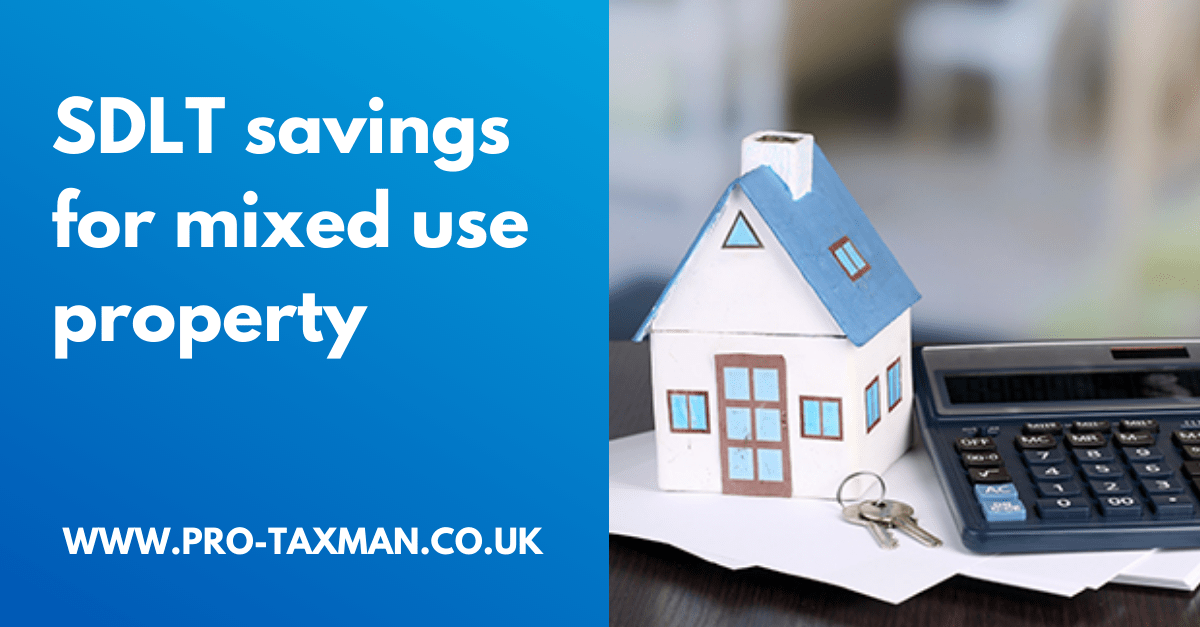Different stamp duty land tax (SDLT) rates apply to residential and to commercial properties. The residential rates are higher, particularly where the 3% supplement for second and subsequent properties applies.
Mixed land and property
Mixed-use land and property is land and property that comprises both residential and non-residential elements. Non- residential property includes:
- commercial property, such as shops and offices;
- property that is not suitable for living in;
- forests;
- agricultural land which is part of a working farm or which is used for agricultural purposes;
- any other land or property that is not used as part of a dwelling’s garden or grounds; and
six or more residential properties purchased in a single transaction.
An example of a mixed-use property would be the purchase of a shop with a flat above.
SDLT on mixed-use properties: current rules
Under the current rules, the commercial property rates apply to mixed dwellings regardless of the split between the residential and non-residential elements. The SDLT payable on a mixed-use property can be significantly less than on a residential property of the same value.
Example
Harry buys a shop with a flat above it on 1 March 2022 for £500,000. His brother Luke buys a house for £500,000 completing on the same day.
Harry pays SDLT at the commercial rates, resulting in an SDLT bill of £14,500 ((£150,000 @ 0%) + (£100,000 @ 2%) + (£250,000 @ 5%)).
Luke pays SDLT at the residential rates, resulting in an SDLT of £15,000. If the second and subsequent property supplement applies, the SDLT bill will be £30,000. The supplement adds an additional £15,000 to the bill (£500,000 @ 3%).
Having a non-residential element, particularly where the 3% supplement would apply to a residential purchase, can significantly reduce the SDLT payable.
Possible changes to the rules
In November 2021, the Government published a consultation exploring changes to the way in which SDLT is charged on mixed-use properties. The consultation ran until 22 February 2022.
The current rules for taxing mixed-use property can lead to distortions as the commercial property rates apply regardless of the extent of the residential element. Consequently, a property with a very small non-residential element will pay SDLT at the lower commercial rates. The savings as against the residential rates can be significant, particularly where the additional dwellings supplement would apply were the property fully residential.
To address attempts to exploit the mixed-use property SDLT rules, the consultation sought views on the introduction of an apportionment basis for mixed-use property. Under the proposed rules, purchasers would be required to apportion the tax for a property such that SDLT at the residential rates would be charged on residential land and SDLT at the commercial rates would be charged on the non-residential land. The consultation document contains the following explanation of how this would work.
‘This would be done firstly by working out the proportions of the whole consideration relating to residential and non-residential property elements. Tax would then be calculated on the assumption that the whole consideration was for residential property, and again separately on the assumption that the whole consideration was for non-residential property. The two tax figures produced would then be reduced by the proportions of the whole consideration relating to residential and non -residential property elements. Finally, the reduced tax figures would be added together to get the final tax bill.’
Example
Toby purchases a property for £1 million that includes grazing land which is commercially let to a third party for the grazing of horses. The additional dwellings supplement does not apply.
The grazing land accounts for 5% of the value of the property.
Under the proposed apportionment rule, the SDLT would be calculated as follows:
- SDLT on the whole at the residential rates = £43,750
- SDLT at commercial rates = £39,500
- Apportionment calculations (£43,750 @ 95%) + (£39,500 @ 5%) = £43,537.50.
The SDLT under the proposed rules is £4,037.50 more than under the current rules.
Plan ahead
As a change to the rules look likely, those planning on purchasing a mixed-use property may wish to do so sooner rather than later to take advantage of the current SDLT rules for mixed-use property.
Need professional accounting service or accounting advice? Contact us to book a 15-min Free Consultation with us today.
To find out more please follow us on Facebook, Twitter, or LinkedIn. Feel free to contact us on 0333 006 4847 or request a call back by texting 075 6464 7474

